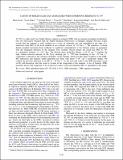| dc.contributor.author | Jiang, Bing | |
| dc.contributor.author | Chen, Yang | |
| dc.contributor.author | Wang, Junzhi | |
| dc.contributor.author | Zhou, Xin | |
| dc.contributor.author | Safi-Harb, Samar | |
| dc.contributor.author | DeLaney, Tracey | |
| dc.contributor.author | Su, Yang,Ph. D.Massachusetts Institute of Technology. | |
| dc.date.accessioned | 2015-03-05T17:56:01Z | |
| dc.date.available | 2015-03-05T17:56:01Z | |
| dc.date.issued | 2010-04 | |
| dc.date.submitted | 2009-09 | |
| dc.identifier.issn | 0004-637X | |
| dc.identifier.issn | 1538-4357 | |
| dc.identifier.uri | http://hdl.handle.net/1721.1/95882 | |
| dc.description.abstract | 3C 397 is a radio and X-ray bright Galactic supernova remnant (SNR) with an unusual rectangular morphology. Our CO observation obtained with the Purple Mountain Observatory at Delingha, Qinghai Province, China reveals that the remnant is well confined in a cavity of molecular gas and embedded at the edge of a molecular cloud (MC) at the local standard of rest systemic velocity of ~32 km s[superscript –1]. The cloud has a column density gradient increasing from southeast to northwest, perpendicular to the Galactic plane, in agreement with the elongation direction of the remnant. This systemic velocity places the cloud and SNR 3C 397 at a kinematic distance of ~10.3 kpc. The derived mean molecular density (~10-30 cm[superscript –3]) explains the high volume emission measure of the X-ray emitting gas. A [superscript 12]CO line broadening of the ~32 km s[superscript –1] component is detected at the westmost boundary of the remnant, which provides direct evidence of the SNR-MC interaction and suggests multi-component gas there with dense (~10[superscript 4] cm[superscript –3]) molecular clumps. We confirm the previous detection of an MC at ~38 km s[superscript –1] to the west and south of the SNR and argue, based on H I self-absorption, that the cloud is located in the foreground of the remnant. A list of Galactic SNRs presently known and suggested to be in physical contact with environmental MCs is appended in this paper. | en_US |
| dc.description.sponsorship | National Natural Science Foundation (China) (grant 10725312) | en_US |
| dc.description.sponsorship | National Natural Science Foundation (China) (973 Program grant 2009CB824800) | en_US |
| dc.description.sponsorship | National Natural Science Foundation (China) (grant 10673003) | en_US |
| dc.description.sponsorship | Natural Sciences and Engineering Research Council of Canada | en_US |
| dc.description.sponsorship | Canada Research Chairs (Program) | en_US |
| dc.language.iso | en_US | |
| dc.publisher | Institute of Physics/American Astronomical Society | en_US |
| dc.relation.isversionof | http://dx.doi.org/10.1088/0004-637x/712/2/1147 | en_US |
| dc.rights | Article is made available in accordance with the publisher's policy and may be subject to US copyright law. Please refer to the publisher's site for terms of use. | en_US |
| dc.source | American Astronomical Society | en_US |
| dc.title | CAVITY OF MOLECULAR GAS ASSOCIATED WITH SUPERNOVA REMNANT 3C 397 | en_US |
| dc.type | Article | en_US |
| dc.identifier.citation | Jiang, Bing, Yang Chen, Junzhi Wang, Yang Su, Xin Zhou, Samar Safi-Harb, and Tracey DeLaney. “CAVITY OF MOLECULAR GAS ASSOCIATED WITH SUPERNOVA REMNANT 3C 397.” The Astrophysical Journal 712, no. 2 (March 11, 2010): 1147–1156. © 2010 American Astronomical Society. | en_US |
| dc.contributor.department | MIT Kavli Institute for Astrophysics and Space Research | en_US |
| dc.contributor.mitauthor | DeLaney, Tracey | en_US |
| dc.relation.journal | Astrophysical Journal | en_US |
| dc.eprint.version | Final published version | en_US |
| dc.type.uri | http://purl.org/eprint/type/JournalArticle | en_US |
| eprint.status | http://purl.org/eprint/status/PeerReviewed | en_US |
| dspace.orderedauthors | Jiang, Bing; Chen, Yang; Wang, Junzhi; Su, Yang; Zhou, Xin; Safi-Harb, Samar; DeLaney, Tracey | en_US |
| dc.identifier.orcid | https://orcid.org/0000-0002-0338-296X | |
| mit.license | PUBLISHER_POLICY | en_US |
| mit.metadata.status | Complete | |
